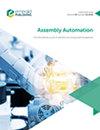Coaxiality and perpendicularity prediction of saddle surface rotor based on deep belief networks
IF 1.7
4区 计算机科学
Q3 AUTOMATION & CONTROL SYSTEMS
引用次数: 0
Abstract
Purpose Aiming at the problem that the transmission mechanism of the assembly error of the multi-stage rotor with saddle surface type is not clear, the purpose of this paper is to propose a deep belief network to realize the prediction of the coaxiality and perpendicularity of the multi-stage rotor. Design/methodology/approach First, the surface type of the aero-engine rotor is classified. The rotor surface profile sampling data is converted into image structure data, and a rotor surface type classifier based on convolutional neural network is established. Then, for the saddle surface rotor, a prediction model of coaxiality and perpendicularity based on deep belief network is established. To verify the effectiveness of the coaxiality and perpendicularity prediction method proposed in this paper, a multi-stage rotor coaxiality and perpendicularity assembly measurement experiment is carried out. Findings The results of this paper show that the accuracy rate of face type classification using convolutional neural network is 99%, which meets the requirements of subsequent assembly process. For the 80 sets of test samples, the average errors of the coaxiality and perpendicularity of the deep belief network prediction method are 0.1 and 1.6 µm, respectively. Originality/value Therefore, the method proposed in this paper can be used not only for rotor surface classification but also to guide the assembly of aero-engine multi-stage rotors.基于深度信念网络的鞍面转子同轴度和垂直度预测
目的针对鞍面型多级转子装配误差传递机理不明确的问题,提出一种深度信念网络,实现多级转子同轴度和垂直度的预测。首先,对航空发动机转子的表面类型进行了分类。将转子表面轮廓采样数据转换为图像结构数据,建立了基于卷积神经网络的转子表面类型分类器。然后,针对鞍面转子,建立了基于深度信念网络的同轴度和垂直度预测模型。为了验证本文提出的同轴度和垂直度预测方法的有效性,进行了多级转子同轴度和垂直度装配测量实验。结果表明,基于卷积神经网络的人脸类型分类准确率达99%,满足后续装配过程的要求。对于80组测试样本,深度信念网络预测方法的同轴度和垂直度平均误差分别为0.1和1.6µm。因此,本文提出的方法不仅可以用于转子表面分类,还可以用于指导航空发动机多级转子的装配。
本文章由计算机程序翻译,如有差异,请以英文原文为准。
求助全文
约1分钟内获得全文
求助全文
来源期刊

Assembly Automation
工程技术-工程:制造
CiteScore
4.30
自引率
14.30%
发文量
51
审稿时长
3.3 months
期刊介绍:
Assembly Automation publishes peer reviewed research articles, technology reviews and specially commissioned case studies. Each issue includes high quality content covering all aspects of assembly technology and automation, and reflecting the most interesting and strategically important research and development activities from around the world. Because of this, readers can stay at the very forefront of industry developments.
All research articles undergo rigorous double-blind peer review, and the journal’s policy of not publishing work that has only been tested in simulation means that only the very best and most practical research articles are included. This ensures that the material that is published has real relevance and value for commercial manufacturing and research organizations.
 求助内容:
求助内容: 应助结果提醒方式:
应助结果提醒方式:


